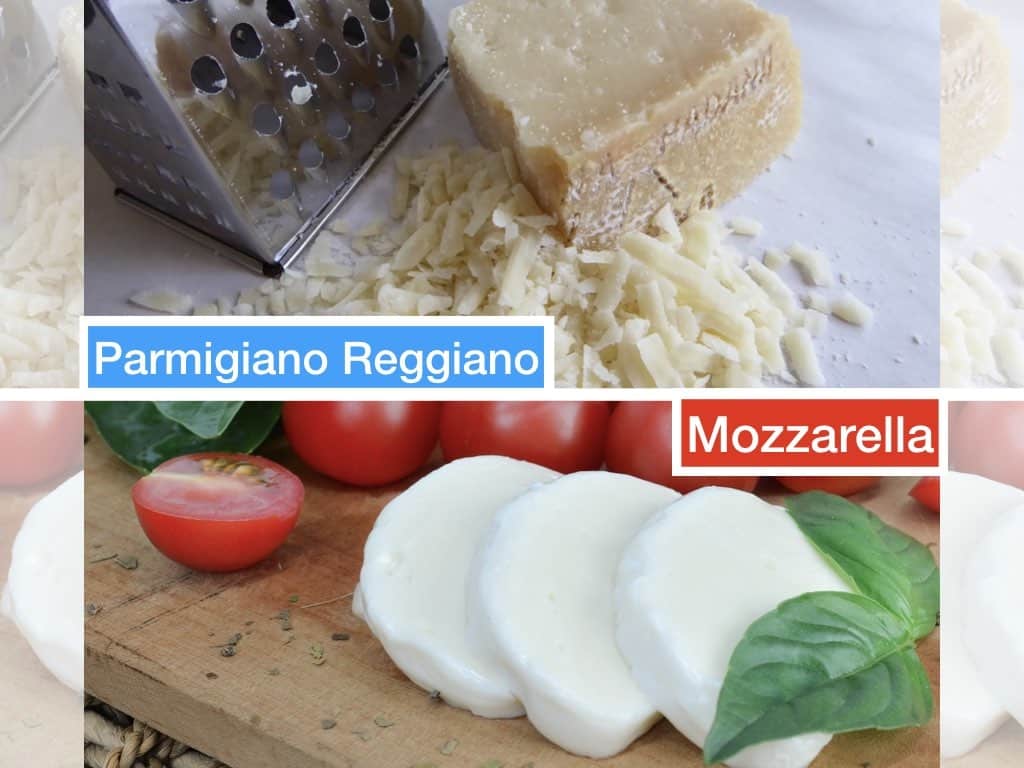Last Updated on June 3, 2022 by Aaron
As a food blogger, I’m often asked to comment on the relative merits of different types of cheeses.
My answer is always that it really depends on what you’re cooking or eating!
That said, there are two very common types – mozzarella and parmesan – which can be used for many dishes.
Here’s my take on these cheeses:
The first thing you should know about mozzarella cheese is where it comes from. Mozzarella di Bufala Campana (aka bufala) is made in Italy with water buffalo milk, while the American version (aka fake mozzarella) is made mostly with cow’s milk. The Italian variety has a much higher fat content than its American counterpart; as a result, it’s creamier and has a rich flavor.
Table of Contents
Like mozzarella, Parmigiano-Reggiano (aka parmesan) comes from a specific place – Parma, Reggio Emilia, Modena, and Bologna, in northern Italy.
This cheese is made from cow’s milk (although there is a version made from sheep’s milk), and must be aged for at least 12 months. The result is a hard, crumbly cheese with a nutty, complex flavor. Parmesan is great on its own or grated over pasta or pizza.
Texture
Texture-wise, mozzarella is more rubbery and stretchy than Parmesan. It’s also a little wetter and doesn’t have the same “crunch” that you get with aged Parmesan. Parmesan is a much harder cheese, so it doesn’t melt as easily as mozzarella.
Which cheese you choose depends on what you’re making. If you want a pizza with a chewy crust, then mozzarella is the way to go. If you want a topping that will melt and create a stringy texture, go for mozzarella.
Parmesan melts too, but you’ll get a much different texture.
Flavor Profile
The mozzarella and the parmesan cheese have a different flavor profiles. The mozzarella is a little bit sweeter and creamier, while the parmesan is a little bit saltier and has a nuttier flavor.
How They Made Differently
Mozzarella and Parmesan cheese are made differently. Mozzarella is a fresh, unaged cheese that’s formed into balls by a process called pasta filata and packed in liquid (water or brined water). There’s no aging involved.
Parmesan starts out as mozzarella but then it gets pressed, brined for 20 days, salted with dry salt, and then aged for at least 12 months.
How to Serve and Use
Mozzarella is great on its own, in salads, or as part of a cheeseboard. It’s also perfect for pizza – it melts easily and gives the crust a chewy texture.
Parmesan can be grated over pasta, risotto, or salad. You can also use it to make sauces (like pesto) or add it to soups.
Which One Is Better?
That’s a tough question! They both have their own unique qualities that make them perfect for different dishes. I’d say that if you’re making pizza, go with mozzarella – it gives the crust a great texture. If you’re looking for a cheese to grate over pasta or salad, Parmesan is the way to go.
Which One Is Healthier?
Both mozzarella and Parmesan are considered healthy by calories. A one-ounce serving of mozzarella has about 78 calories, while a one-ounce serving of Parmesan has about 122 calories (USDA). So Parmesan has a bit more calories, but not by much.
Both Parmesan and mozzarella are high in protein, calcium, phosphorus, sodium, zinc vitamin A. Traditional mozzarella has a higher fat content than parmesan (because it’s made with water buffalo milk), but both cheeses contain an average of 60% (for 100g consumed) of your daily recommended value of saturated fat.
Can I Substitute Mozzarella for Parmesan?
You can, but you won’t get the same results. Parmesan has a much stronger flavor than mozzarella and it will change the overall taste of your dish. In Italy, they use parmesan in many dishes that call for cheese because its strong flavor adds lots of depth to recipes.

